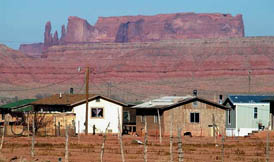On August 7, the day my wife and I arrived in Kamloops, British Columbia, the headline in Canada’s national newspaper read “Tories Prepare New Native Land Plan.” We were in Kamloops to meet with Manny Jules, former chief of the Kamloops Band of the Shuswap First Nation and the idea entrepreneur behind the proposed legislation.
Dubbed the “First Nations Property Ownership Act,” the legislation would allow Canadian bands (tribes as they are known in the United States) to vote on whether to give individual Indians the right to own their land as private property. If the act passes and if bands vote in favor of allowing private ownership, all lands on reservations would be converted to private property with all the privileges and responsibilities of fee simple title. As Manny puts it, “All we are asking for is the same right that other Canadian citizens have: the right to own property.”
Currently, land on Canadian Indian reserves is held primarily under “certificates of possession” or “customary use rights.” In both cases land boundaries and use rights are often not clear and, even if they are, title cannot be transferred to others. The result is what Hernando de Soto calls “dead capital” because the land cannot be used as collateral for loans to improve the property and cannot be sold to others who might have the capital. At best, land can be leased, but getting approval from the Ministry of Indian Affairs for a lease of sufficient length to encourage investment is not easy.
Manny’s idea for the legislation was stimulated by his father, also a former chief, who managed to issue 99-year leases for an industrial site on part of the Shuswap Reserve. Standing on a hill across the valley from the reserve, we did not need Manny to point out where the site was; it, and the Sun Rivers Golf Course and housing development, also with long-term leases, were the only developed land on the prime real estate fronting the Thompson River. Later, on a driving tour, it was again obvious where the reserve ended and private property began. The reserve side of the fence was brown grass, which would require dozens of acres to support a single cow while the private side was a lush green irrigated field.
Recently, President Obama signed legislation also designed to help American Indian tribes develop their land. The Helping Expedite and Advance Responsible Tribal Homeownership (HEARTH) Act enables tribes to lease their lands for up to 25 years for residential, business, public, religious, educational, or recreational purposes without needing the approval of the Secretary of the Interior.
Obviously the HEARTH Act falls far short of what is being proposed in Canada. In contrast to the United States, where the relationship between tribes and the federal government is that of “a ward to its guardian” as declared by a U.S. Supreme Court case in 1833, the Canadian act recognizes that Indians are capable of managing their own affairs. Of course, some tribal leaders oppose the proposed legislation, worrying that private ownership will lead to the sale of Indian lands to non-Indians and result in failures that can come with free enterprise. Manny, in an interview on Canadian national television, responded, “We just want the opportunity to decide for ourselves.”
One does not have to perform sophisticated statistical analyses, though several PERC scholars have done so, to explain why Indian reserves in Canada and Indian reservations in the United States are bastions of poverty. The lack of property rights and a rule of law are the reasons for poverty on both sides of the border as well as around the world. (On the latter point, I heartedly recommend Why Nations Fail by Daron Acemoglu and James Robinson.)
Over the next two years, PERC scholars, with a generous grant from the M. J. Murdock Charitable Trust, will be studying the potential for Indians to choose their own destiny, lift themselves out of poverty, and improve their environmental quality at the same time. This special issue of PERC Reports is part of that on-going research effort. In addition to conferences and scholarly research, PERC will develop a contracting guide for ecosystem services provided on Indian lands and will work with the Tulo Institute at Thompson River University in Kamloops to develop an online textbook for Indian leaders to better understand the institutions necessary for development.
The continent’s first inhabitants have a rich institutional background illustrating their ability to get the incentives right. It is now time for the federal governments north and south of the border to acknowledge this history and return to Indians the dignity and respect they deserve.




